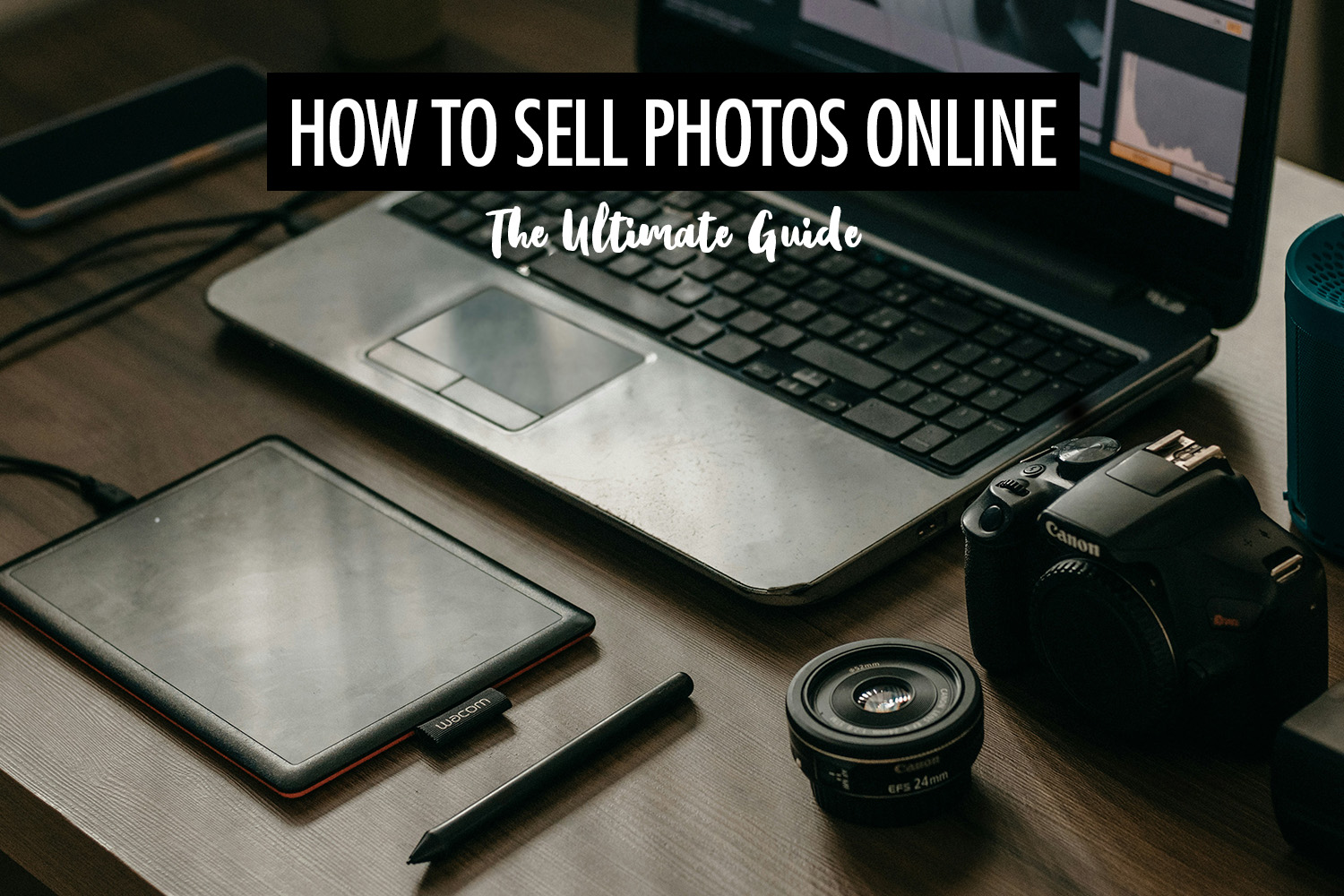In today’s digital-first world, photography has evolved from a hobby into a legitimate source of income for many. With brands, bloggers, marketers, and publishers constantly in need of fresh visuals, the demand for high-quality photos has never been higher. Whether you’re a seasoned professional with a DSLR or a hobbyist capturing stunning moments on your smartphone, there’s a global market ready to pay for your work. The good news? You don’t need to rent a gallery or print physical copies—you can sell your photos online from the comfort of your home.
The internet has made it incredibly easy to monetize your photography. From stock photo websites and print-on-demand marketplaces to building your own online store, there are countless platforms that connect photographers with potential buyers. Some allow you to upload photos and earn money passively by collecting royalties over time, while others offer more direct-to-customer selling experiences. But like any business, success depends on strategy—knowing the right places to sell your photos, what kind of photos perform well, how to price them, and how to market yourself effectively.
This article will walk you through everything you need to know to start selling your photos online. We’ll explore the top websites, profitable photo niches, pricing strategies, legal requirements, and essential tools to help you turn your portfolio into a revenue stream. Whether you’re looking to build a side hustle or grow a full-time photography business, you’ll find practical tips and insights to get started and scale up confidently.
Types of Photos That Sell Well

Not all photos are created equal—especially when it comes to what actually sells online. Understanding which categories are in high demand can help you focus your efforts, build a more marketable portfolio, and increase your chances of generating consistent income. While trends evolve over time, several categories of photos have proven to be consistent top performers across various platforms.
Business and Lifestyle Photography
Photos that depict real people in natural settings—working, socializing, using technology, or simply living day-to-day moments—are among the most downloaded on stock sites. Think shots of coworkers in meetings, remote work setups, families at dinner, or friends enjoying coffee together. The key is authenticity; overly staged or generic images tend to perform poorly compared to candid, relatable visuals.
Technology and Innovation
From AI and robotics to smart homes and wearable tech, the digital age is shaping photo trends. Images of people interacting with gadgets, coding at a computer, or illustrating data flow are often used in editorial and commercial content, making this a profitable niche for tech-savvy photographers.
Travel and Nature
Breathtaking landscapes, cityscapes, and cultural moments remain evergreen in demand. Travel bloggers, magazines, and tourism boards are always on the lookout for striking visuals that tell a story about a place. If you have a library of well-composed shots from your travels, you’re already ahead.
Health and Fitness
As the wellness industry continues to grow, so does the demand for related imagery. Photos of people exercising, preparing healthy meals, meditating, or engaging in sports like yoga or running are widely used in fitness blogs, health apps, and marketing campaigns.
Education and School Photography
Photos related to education are always in demand—from preschool classrooms to university campuses. Shots of students studying, teachers in action, children using tablets, or graduation ceremonies are frequently used in brochures, blogs, and e-learning platforms. School portraits and event photography (like senior photos, class photos or awards days) can also be monetized directly, especially when paired with platforms that offer private galleries and face-recognition tagging.
Food and Drink
Beautifully styled shots of meals, beverages, or food preparation scenes are staples for restaurants, cookbooks, and food blogs. Whether it’s a flat lay of a brunch spread or a macro shot of melting chocolate, food photography can be highly profitable when done with attention to detail and lighting.
Sports and Action Photography
Dynamic, high-energy images of sports events—whether it’s local youth games, high school tournaments, marathons or professional competitions—sell well across both stock and private galleries. There’s strong demand for shots that capture the emotion and intensity of the game: a decisive moment, a team huddle, or an athlete’s celebration. These photos are especially valuable to parents, schools, and sports organizations, offering both print and digital sales opportunities.
Diversity and Inclusion
Brands and publishers are actively seeking imagery that reflects the real world—diverse ethnicities, body types, ages, and lifestyles. Inclusive images that feel natural and respectful are not only ethically important but also commercially in demand.
By focusing on these popular categories—and adding your own creative spin—you can build a portfolio that appeals to a wide range of buyers. And if you have access to school events or sports teams in your community, don’t overlook the potential in selling your photos directly to families, institutions, and local media. These niches are often underserved and can yield recurring, hyperlocal income streams.
Stock Photo Platforms
A stock photo marketplace is an online platform where photographers can sell their photos to individuals, businesses, and media outlets for a variety of uses—ranging from website content and advertisements to editorial features and merchandise. These marketplaces act as intermediaries, connecting creators with buyers by hosting searchable libraries of photos categorized by subject, theme, and usage rights.
Photographers upload photos and earn money each time their images are licensed, typically through royalty payments based on the license type and pricing model. For creators, stock photo marketplaces offer an accessible way to generate passive income from their work, while providing clients with high-quality visuals without the cost of a custom photo shoot.
Alamy
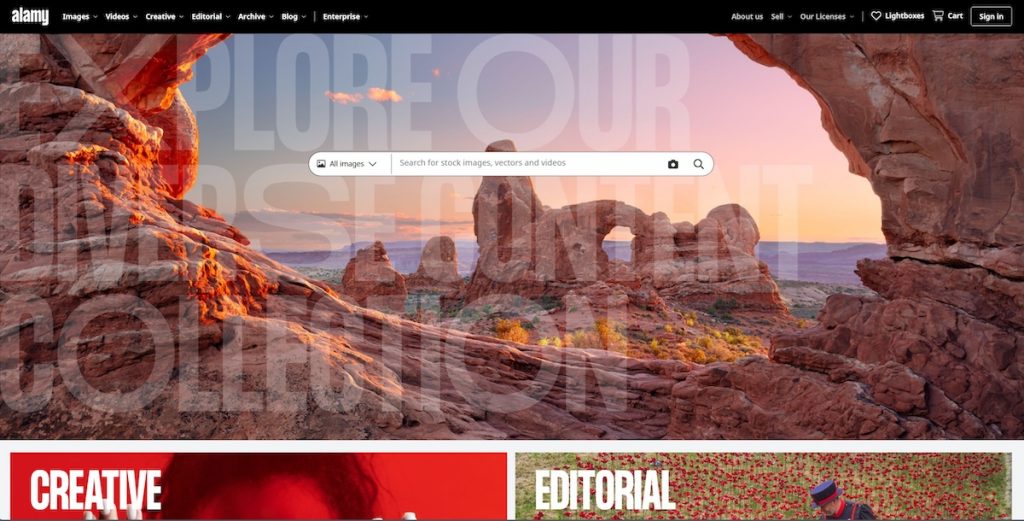
Alamy is a UK-based stock photography platform offering photographers the flexibility to sell their photos under royalty-free or rights-managed terms. Contributors can upload content either exclusively or non-exclusively and receive payouts via PayPal, Skrill, or direct bank transfer. The platform offers a relatively generous commission structure: 50% for exclusive content and 40% for non-exclusive, according to its contributor terms. This dual licensing model allows photographers to tailor rights for different clients—broad use under royalty-free or specific use through rights-managed licenses.
Alamy stands out for its strength in editorial and documentary content, appealing to photographers with niche or newsworthy portfolios. Its global reach and higher-than-average commission rates add to its appeal, although contributors should note that visibility and sales may depend on Alamy’s search algorithm and shifting market demand. Periodic updates to terms and commission models also warrant close monitoring. Overall, Alamy is a solid choice for photographers looking to monetize large, diverse image collections while retaining control over licensing terms.
500px
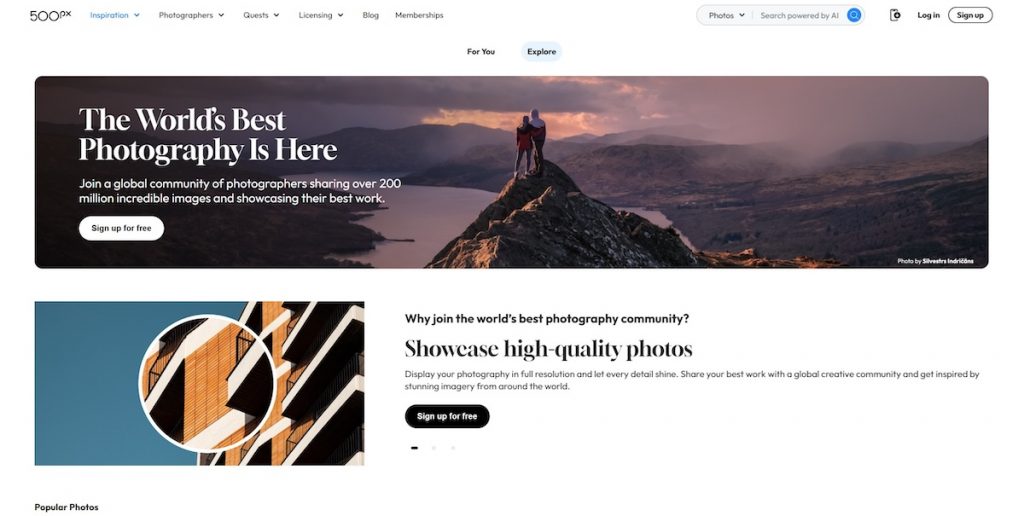
500px is a photography community and licensing platform where contributors can sell their photos through its royalty-free Licensing Program. Once images are submitted and approved, they become available for purchase by commercial clients. Contributors can license their work exclusively or non-exclusively, with exclusive licenses earning up to 60% of net sales, while non-exclusive licenses earn a lower percentage.
To receive payments, contributors must complete a one-time setup with tax documents and payment details. Supported payout methods include PayPal, eCheck/local bank transfer, ACH, and wire transfer, each with different associated fees. The platform processes payments every 10 to 15 business days once contributors meet the $30 minimum payout threshold.
500px offers a streamlined way for you to sell photos online, with flexible licensing options and a straightforward payment process. However, standing out requires consistent quality and uniqueness, as competition is high and visibility depends heavily on content standards and curation.
123RF
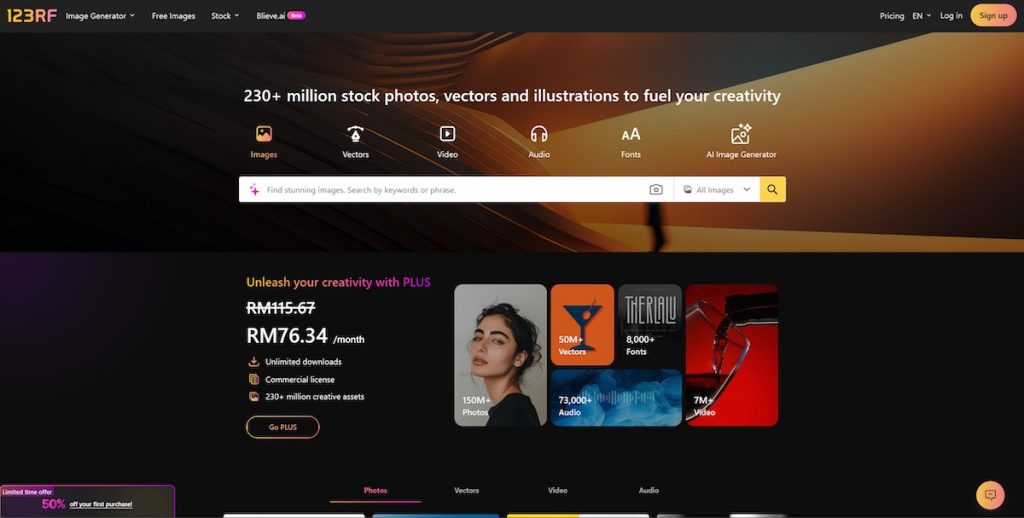
123RF is a global stock content platform where contributors can sell photos, vectors, videos, and audio files through royalty-free models. The platform operates on a non-exclusive basis, allowing photographers to retain ownership and distribute their content elsewhere. Contributor earnings follow a tiered commission structure ranging from 30% to 60%, based on annual sales volume. Payments are issued automatically on or after the 15th of each month once contributors reach the minimum payout threshold—$50 for PayPal and Payoneer, and $100 for Skrill. Available payment options include PayPal, Skrill, Payoneer, and Alipay (for contributors in China).
123RF offers multiple license types to cater to client needs: Standard for general commercial and personal use, Extended for broader applications like resale or mass distribution, and Editorial for news or educational contexts. Contributors must provide appropriate model or property releases where applicable. With flexible licensing, a global customer base, and a straightforward payout system, 123RF is a viable option for photographers seeking wide exposure and consistent earnings.
Shutterstock
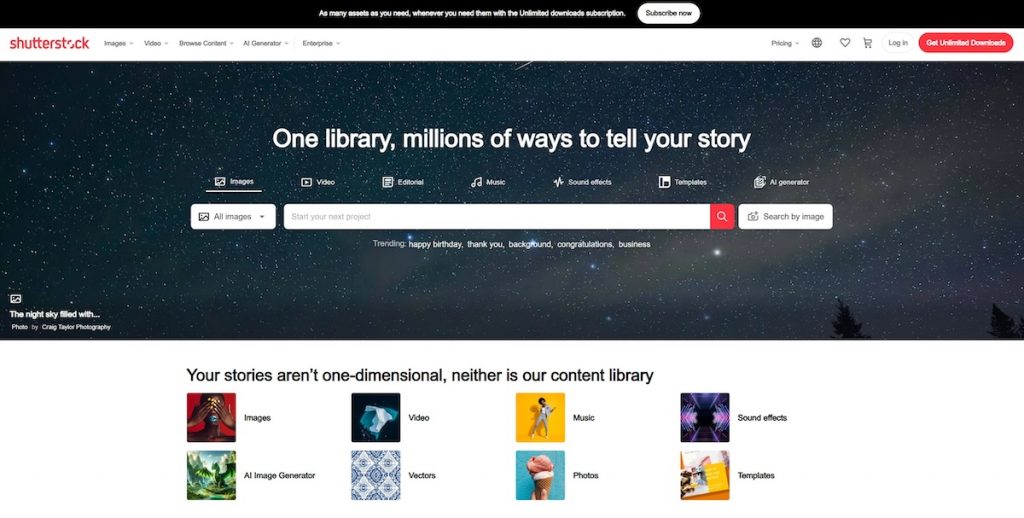
Shutterstock is a leading stock content platform enabling contributors to sell their photography, illustration, and video content through royalty-free licensing. It uses a tiered earnings model based on annual download counts. Contributors start at Level 1 each calendar year, progressing through levels as they reach download milestones, with higher levels earning increased percentages per sale. Payments are processed monthly via PayPal, Skrill, or Payoneer, provided the $25 minimum threshold is met.
Licensing options include Standard and Enhanced licenses. The Standard License permits use in websites, marketing materials, and social media, while the Enhanced License covers broader usage such as merchandise and high-volume print runs. To ensure compliance, contributors must submit model or property releases for any recognizable people or private locations.
Shutterstock’s massive user base and global footprint make it an attractive option for earning passive income, though competition is high and success depends on consistently uploading high-quality, in-demand content.
Getty Images
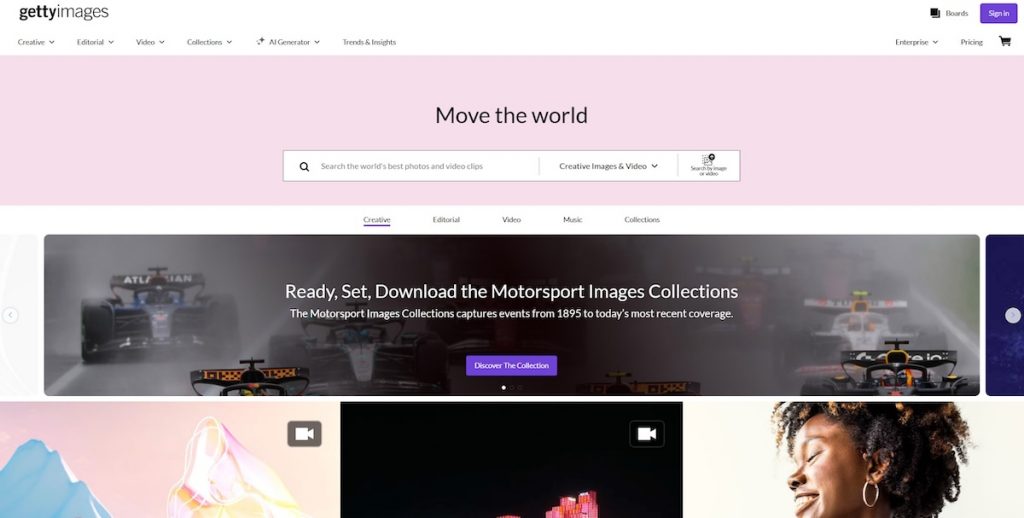
Getty Images is a premier stock platform known for high-quality editorial, creative, and commercial content. Contributors can sell photos under royalty-free, rights-managed, or rights-ready models, providing flexibility to serve various client needs—from global media outlets to marketing agencies. Payments are issued monthly via PayPal or Payoneer once contributors reach the $100 minimum payout threshold.
Royalties vary by exclusivity and license type. Non-exclusive contributors typically earn 20% for royalty-free sales, while exclusive contributors can earn between 25% and 45%, depending on the agreement. Getty’s rigorous quality standards and strong presence in editorial markets make it especially appealing to professional photographers focused on global reach and prestige.
Due to selective onboarding and lower base royalties compared to some platforms, Getty Images is best suited for experienced photographers aiming for high-value licensing and broad international exposure.
iStock
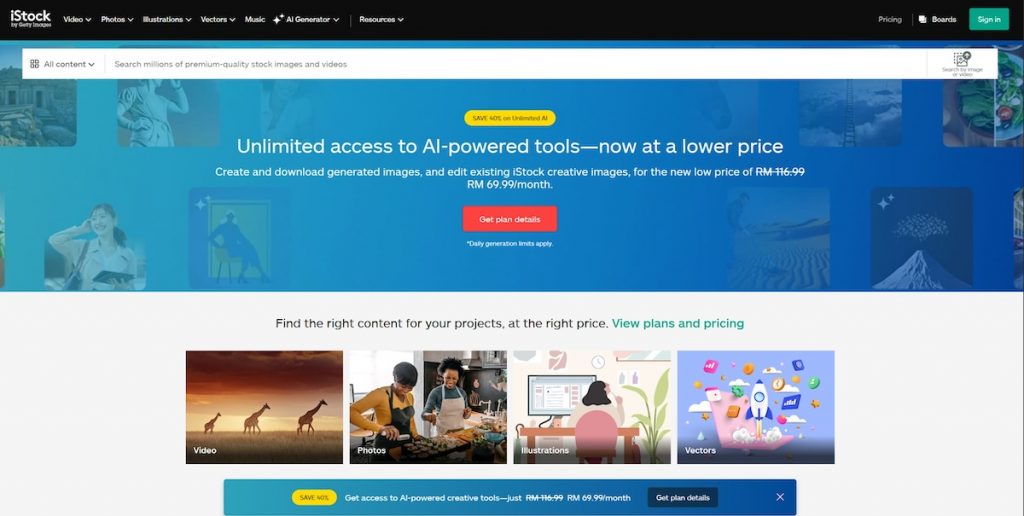
iStock, a subsidiary of Getty Images, is a microstock platform offering royalty-free licensing through exclusive or non-exclusive agreements. Exclusive contributors benefit from tiered royalty rates starting at 25% and reaching up to 45% based on performance. Non-exclusive contributors receive a flat 15% royalty rate, which remains constant regardless of sales volume.
The platform offers Standard and Extended licenses. The Standard License covers general commercial use, while the Extended License permits broader applications such as merchandise and resale. Royalties vary depending on license type and whether the image is purchased via credits or subscriptions—subscription downloads can generate low per-sale earnings, especially for non-exclusive contributors.
Payments are made monthly via PayPal or Payoneer after reaching the $100 payout threshold. While iStock offers high exposure through its integration with Getty Images, contributors should weigh the trade-offs between exclusivity, royalty structure, and subscription-based earnings.
Stocksy

Stocksy is a cooperative stock photography platform that emphasizes fair compensation and creative control. Contributors are members and co-owners, earning 50% royalties on standard licenses and 75% on extended licenses and exclusive deals. These rates far exceed the industry average and reflect the platform’s artist-first ethos.
Photographers must apply and be accepted to join, submitting a curated portfolio for review. Once accepted, they can receive payments via Payoneer, PayPal, or cheque, with a minimum threshold of $100. Licensing options include Standard—covering use in digital and print up to 500,000 copies—and Extended, which allows usage in merchandise and resale-based templates.
Stocksy’s curated approach and equitable royalty model make it ideal for creatives seeking a selective, ethically-driven platform. While competitive and exclusive, the potential for higher earnings and community support distinguishes it from traditional stock agencies.
Adobe Stock
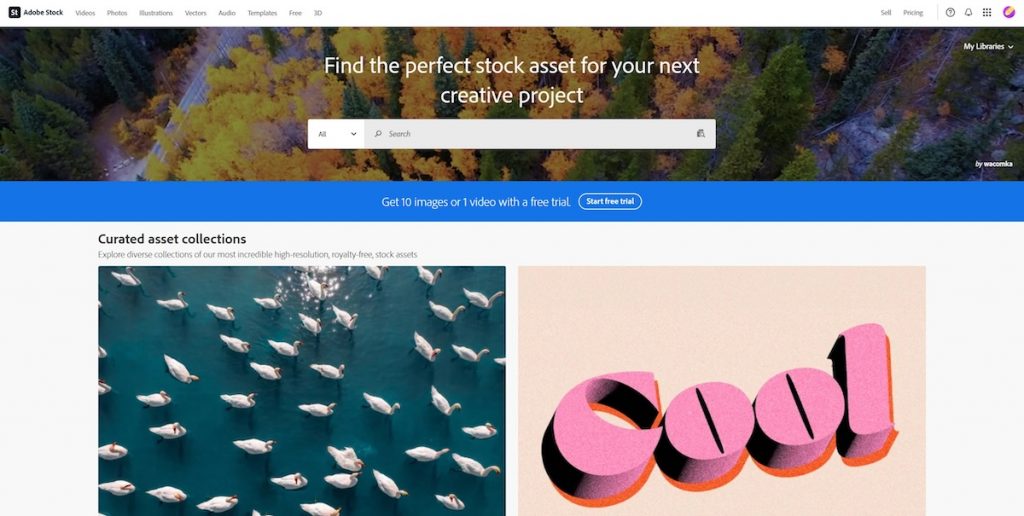
Adobe Stock is a high-visibility stock marketplace tightly integrated with Adobe Creative Cloud. Contributors can sell images, illustrations, vectors, videos, and more, earning 33% royalties for images and 35% for videos. Royalties are based on the net price paid by customers, including discounts from subscriptions or bundles.
Adobe Stock offers Standard and Extended licenses. The Standard License supports typical use cases such as social media, websites, and print (up to 500,000 copies), while the Extended License allows for broader applications including resale. Contributors can also qualify for Creative Cloud subscription bonuses based on annual download performance.
Payments are issued monthly via PayPal, Skrill, or Payoneer once the $25 payout threshold is met. Adobe Stock offers excellent exposure to creative professionals and competitive royalties, making it an appealing option for high-quality content creators.
Envato Elements
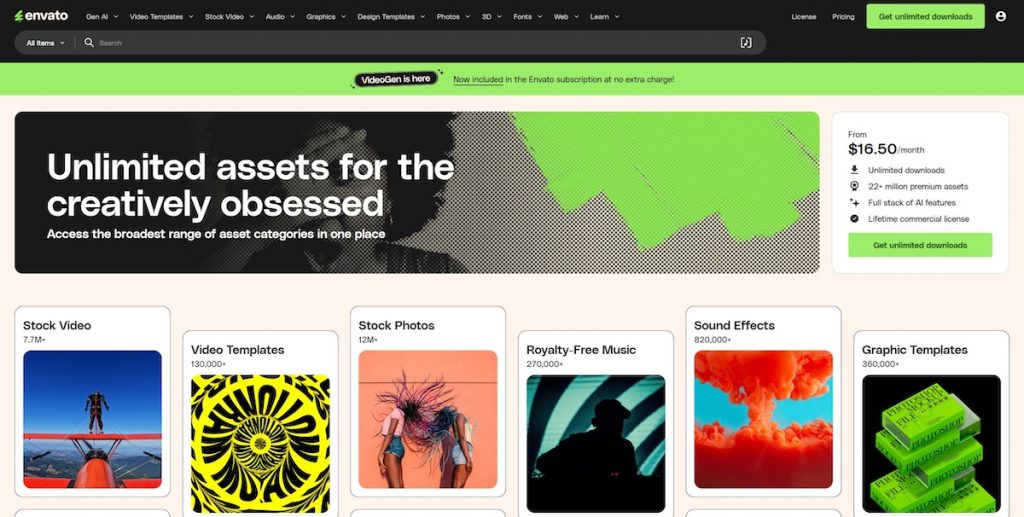
Envato Elements is a subscription-based platform offering a wide range of digital assets, including stock photos, templates, and graphics. Contributors are paid via a “subscriber share” model, where 50% of the platform’s net subscription revenue is split among contributors based on the number of downloads their content receives in each cycle.
All content is licensed under a broad commercial license, allowing use in client projects, websites, and commercial campaigns. Each asset must be licensed per project, ensuring contributors receive fair credit for each use. Payments are made monthly via PayPal, Payoneer, or Skrill once the $50 threshold is met.
Though individual earnings per download may be lower than per-sale platforms, the potential for consistent recurring income and exposure to a large design community make Envato Elements attractive for photographers producing versatile, high-volume content.
Unsplash

Unsplash is best known for its free, high-resolution image library, where users can download and use images for commercial and non-commercial purposes under the Unsplash License—with no requirement for attribution. Selling unaltered images or compiling them for resale is prohibited.
Photographers looking to sell their photos online can apply for Unsplash+, a paid contributor program offering compensation of $10 to $50 per accepted image. Contributors must agree to a non-exclusive, perpetual license allowing Unsplash to market and distribute their content. Payments are made monthly via PayPal after meeting the minimum payout threshold.
While Unsplash’s free-first model emphasizes exposure over revenue, the Unsplash+ program offers a modest income stream for accepted contributors. It’s best suited for photographers seeking visibility or passive income from existing libraries.
Dreamstime
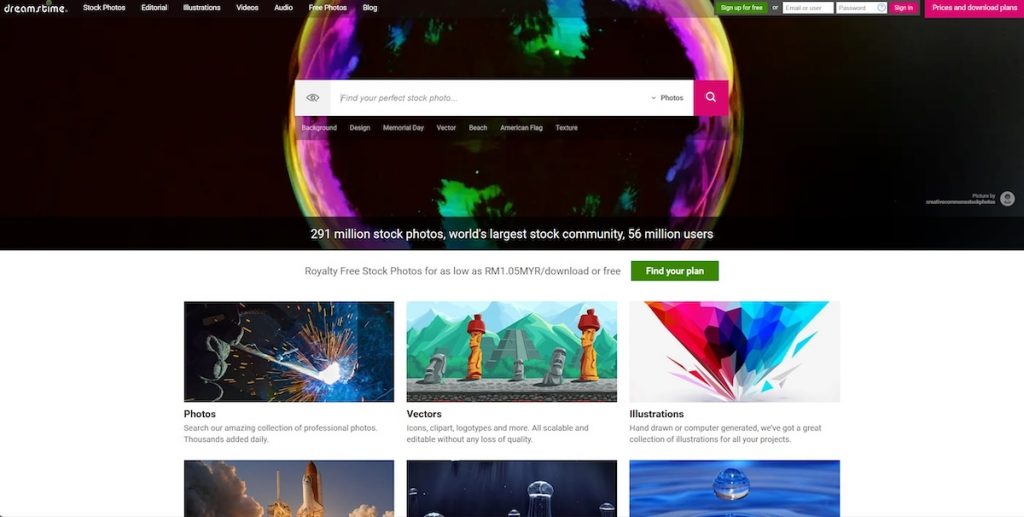
Dreamstime is a microstock platform offering global reach and diverse licensing options for contributors of photos, videos, illustrations, and audio. Royalties range from 50% to 60%, with exclusive contributors earning the higher end. Payments are made via PayPal, Payoneer, Skrill, or bank check, once the $100 payout threshold is reached.
Licensing options include Royalty-Free (RF), Extended Licenses (EL), and Exclusive Licenses. RF licenses allow broad use, while ELs cover resale and high-visibility applications. Exclusive licenses give clients sole rights for a specified time or indefinitely, offering contributors flexibility in pricing and access.
Overall, Dreamstime provides a user-friendly photo selling platform for contributors to sell their creative work online. With competitive royalty rates, diverse licensing options, and a global customer base, it presents a viable opportunity for photographers and artists seeking to generate income from their content.
EyeEm

EyeEm is a global photography platform that allows contributors to sell their photos online through its marketplace and partnerships with platforms like Getty Images and Alamy. Contributors earn 50% of the net revenue from each sale, whether the image is sold directly on EyeEm Market or via partner platforms.
The platform offers multiple licensing options, including Social, Web, and Full licenses, catering to various commercial needs. Additionally, EyeEm’s “Missions” provide photographers with opportunities to participate in themed contests commissioned by brands, offering additional avenues for exposure and income.
Payments to contributors are processed through PayPal, with no minimum payout threshold, allowing for flexible withdrawals. EyeEm also facilitates the sale of prints, enabling photographers to monetize their work further. The platform’s integration with major agencies expands the reach of contributors’ images, potentially leading to increased sales. However, it’s important to note that while EyeEm offers diverse monetization options, earnings can vary based on factors like image quality, market demand, and participation in platform activities.
Online Galleries
Online galleries are secure and customizable platforms that allow photographers to share and sell their work directly to clients in a professional and controlled environment, by building their own photography website. Unlike public stock photo marketplaces, these galleries offer greater flexibility in setting prices, managing licenses, and maintaining brand consistency.
Often protected by passwords or client-specific links, they’re ideal for event, wedding, school, or sports photographers who need to deliver large collections efficiently while preserving privacy. Many platforms also support features like watermarking, print and download options, and integrated payment systems, making them a streamlined solution for turning photo deliveries into sales opportunities.
For many photographers, showcasing tangible products is essential for generating interest and boosting sales. Kelley Hoagland, a maternity and newborn photographer, explains: “Featuring framed photography and fine art albums on my website and social media has helped me book more clients and sell more printed products. Many people today, especially younger generations, view photography sessions as simply receiving digital files. But I’ve come to believe that digital files alone don’t represent a truly finished product, and they can easily be lost. Showing the beauty and longevity of physical prints helps clients understand how I’m helping preserve their family’s memories and legacy.”
SmugMug
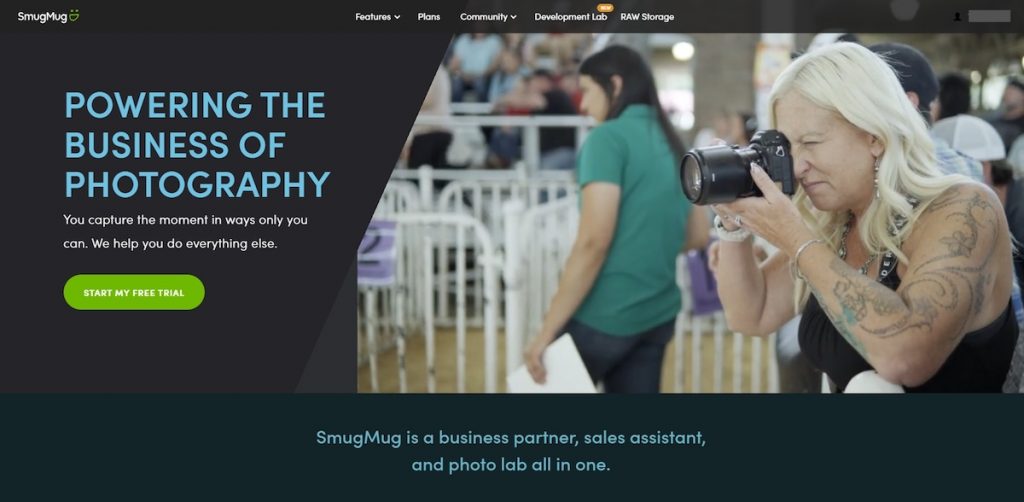
SmugMug is built for photographers who value control, customization, and commercial freedom. Unlike many gallery platforms, SmugMug focuses heavily on branding—offering extensive design customization, white-labeling, and flexible storefront options. Subscription prices start with the Portfolio Plan at $31/month (or $246/year), unlocking unlimited storage and full access to sales tools. The Pro Plan, priced at $45/month (or $384/year), adds advanced features like multiple price lists, client management tools, and marketing coupon systems.
Sales on SmugMug aren’t just about simple downloads—the platform supports curated packages, allows photographers to set their own profit margins, and provides built-in marketing support. Its commission-free model ensures you keep what you earn. Moreover, SmugMug’s integration with top-tier print labs like Bay Photo, WHCC, Fujifilm, and Loxley Colour ensures premium print fulfillment, from canvases to photo books.
SmugMug is best for professionals who want a polished online storefront with robust back-end control. It’s ideal if your brand identity and print quality are just as important as the photos themselves.
Pixieset
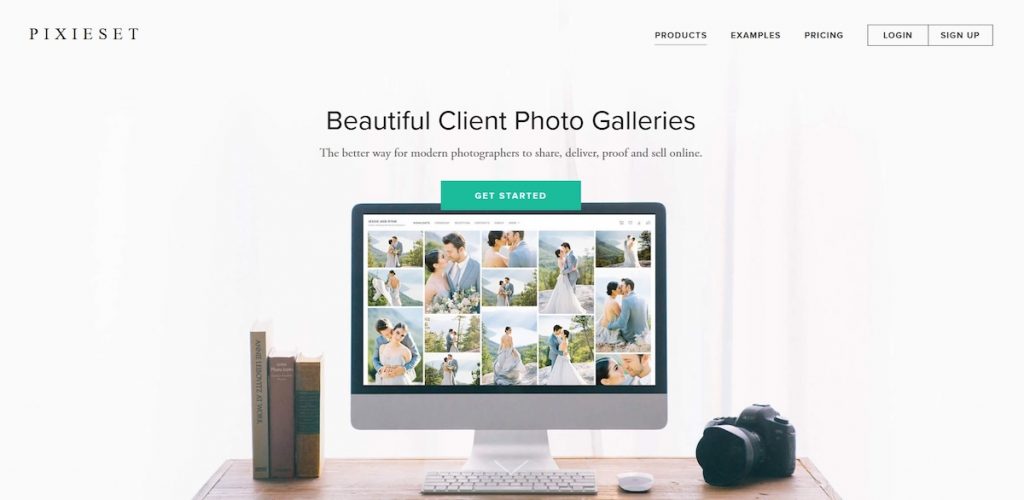
Pixieset offers a clean, all-in-one platform that blends gallery delivery with e-commerce in a way that feels intuitive and beautifully designed. Its pricing is structured across multiple tiers: from a Basic Plan at $10/month with 10GB of storage, up to the Ultimate Plan at $40/month with unlimited storage. Every paid plan removes the 15% sales commission that exists in the free version, allowing photographers to retain 100% of their earnings.
Beyond just delivering photos, Pixieset makes it simple to turn galleries into photo selling opportunities. Photographers can craft detailed price sheets, group offerings into packages, and even schedule promotions using coupon codes and seasonal campaigns. With its integrated store, clients can purchase digital files, prints, or bundles with just a few clicks. On the fulfillment side, Pixieset connects to trusted labs such as WHCC, Miller’s, Mpix, ProDPI, and Loxley Colour—making professional-grade print sales seamless.
Pixieset is an excellent fit for photographers who want a beautiful, client-friendly experience that doesn’t sacrifice selling potential. Its balance of aesthetics and automation makes it especially appealing for lifestyle, portrait, and wedding photographers.
Shootproof
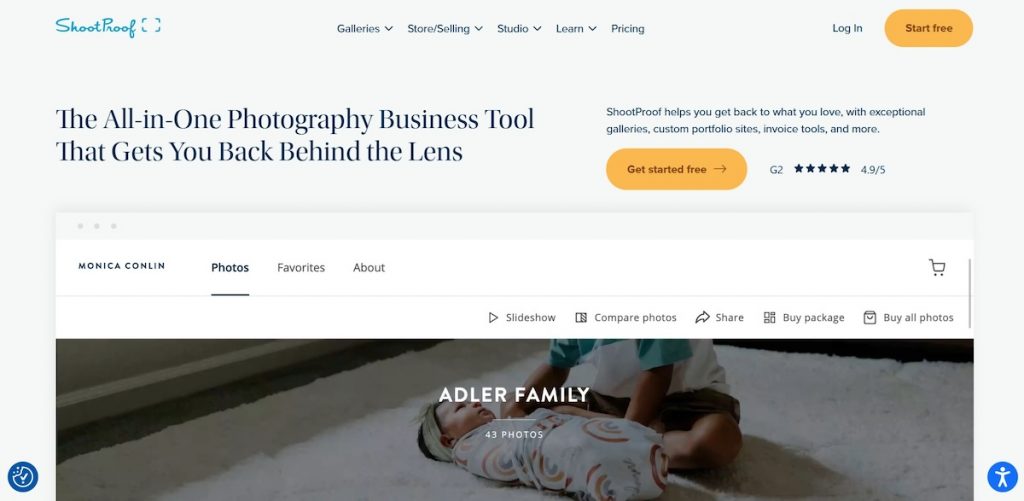
ShootProof positions itself as more than just an online gallery—it’s a full client management ecosystem. Its strength lies in the suite of business tools it bundles in, including contracts, invoicing, and contact management. Plans range from a Free Tier (up to 100 photos) to robust paid options like the 25,000 Photo Plan at $31.99/month, each unlocking unlimited galleries and comprehensive delivery settings.
The platform shines in its versatility: photographers can sell a mix of digital files, prints, or packages, complete with custom price lists and flexible licensing. ShootProof’s built-in email marketing tools make it easy to nurture sales with discount codes or personalized promotions. Print fulfillment is handled through a strong network of professional labs such as WHCC, Bay Photo, Miller’s, and Mpix, giving photographers confidence in the physical products their clients receive.
Family photographer Samantha Shannon notes that using ShootProof has made print sales more intuitive for her clients: “Once I know how a family wants to use their photos, whether for a gallery wall or an heirloom album, I can shoot with purpose. ShootProof’s integration with my lab makes ordering easy for them and keeps the experience professional from start to finish.”
For those who want a more operationally focused platform—where booking, contracts, and sales live in one hub—ShootProof is an efficient, business-first solution without compromising on presentation.
Pic-Time
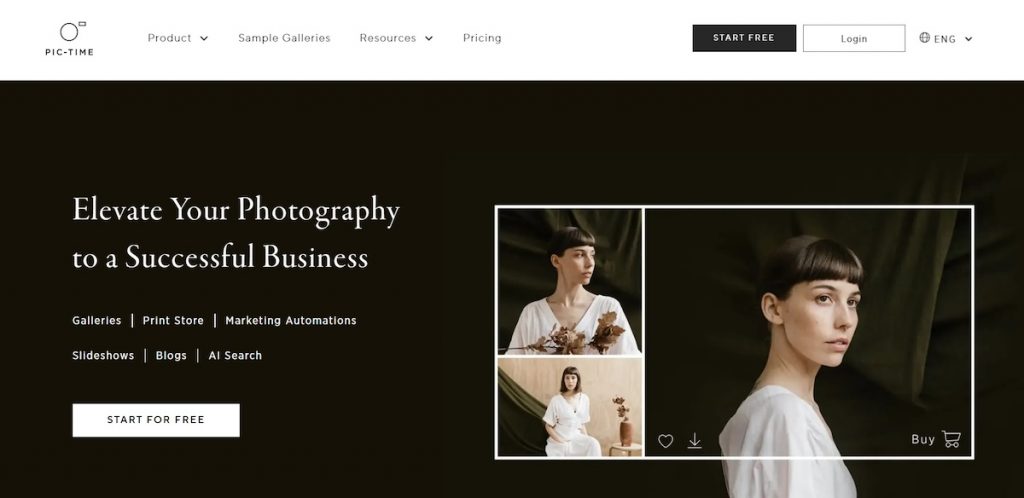
Pic-Time stands out in the online gallery space with its sleek design and emphasis on automation and scalability. Aimed at photographers who want more than just client delivery, Pic-Time doubles as a powerful sales and marketing engine. While the free plan offers 10GB of storage (reduced to 3GB after six months), paid tiers—ranging from $7/month (Beginner) to $42/month (Advanced)—unlock larger storage capacities and advanced features. These include commission-free photo selling when using direct payments, a dedicated mobile app, and access to their automated marketing tools.
Where Pic-Time truly excels is in its e-commerce flexibility and intelligent sales tools. Photographers can create customized product bundles, apply discounts, and trigger automated email campaigns that nudge clients toward purchasing prints and products. Their intuitive store system isn’t just about selling—it’s about selling smarter. Whether it’s gallery banners reminding clients of expiring access or targeted offers for anniversaries, the platform does a lot of the heavy lifting for you.
Adding to its global appeal, Pic-Time is partnered with over 30 professional print labs across multiple continents. This means your clients—from the U.S. to Australia—can receive high-quality prints with minimal turnaround. For photographers looking for a system that combines design, automation, and international fulfillment, Pic-Time delivers a polished, business-savvy solution.
Cloudspot
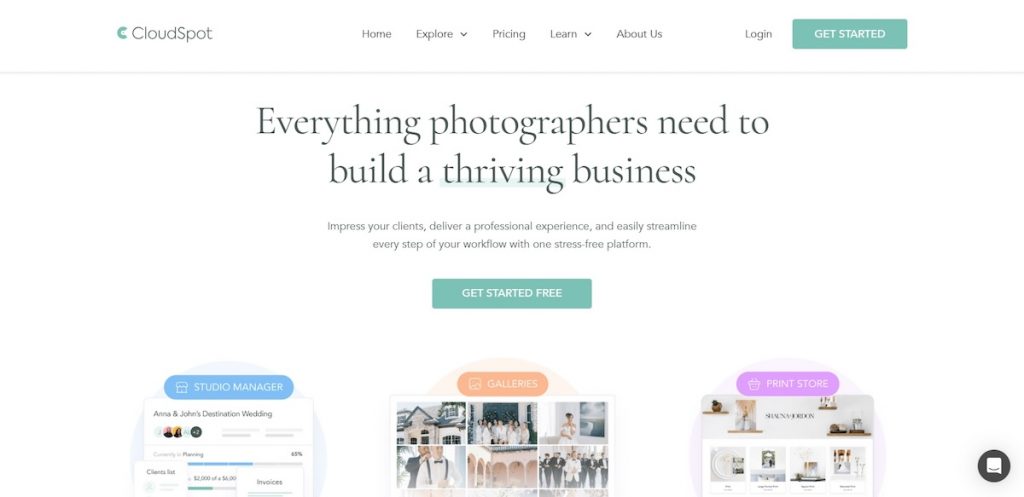
CloudSpot positions itself as a modern, user-friendly solution for photographers who want to deliver galleries, market their work, and sell their photos online—all from one clean interface. Designed with simplicity in mind, CloudSpot offers a range of subscription plans: a Free tier with 10GB of storage, followed by the Lite ($15/month for 100GB), Pro ($30/month for 350GB), and Unlimited ($45/month) plans. Paid tiers unlock commission-free sales (when using your own Stripe or PayPal), access to marketing tools, and streamlined mobile access, making it easy to manage your business on the go.
Beyond basic delivery, CloudSpot offers a smart sales ecosystem built around ease and automation. You can build custom product bundles, set up limited-time discounts, and use built-in email campaigns and banners to drive print and digital sales. The interface is built to support fast workflows—ideal for event photographers juggling multiple galleries—while keeping the client experience polished and simple. Every step, from viewing to purchase, can be tailored to reflect your brand identity.
Kristeen Marie, a professional photographer, noted how easy CloudSpot made everything—for both her and her clients. “It simplified my workflow and improved the client experience from start to finish,” she said. She praised the faster upload times, the clean and modern gallery layout, and the smoother delivery process, adding, “Their customer service has been phenomenal—they walked me through the transition and made it completely painless.”
CloudSpot also integrates with top-tier print labs like WHCC, Miller’s, and Mpix, ensuring clients receive premium physical products with minimal effort on the photographer’s part. With its thoughtful balance of intuitive design, powerful automation, and hands-off fulfillment, CloudSpot is a solid choice for photographers seeking a time-saving photo selling website that doesn’t sacrifice quality or sales potential.
Picfair
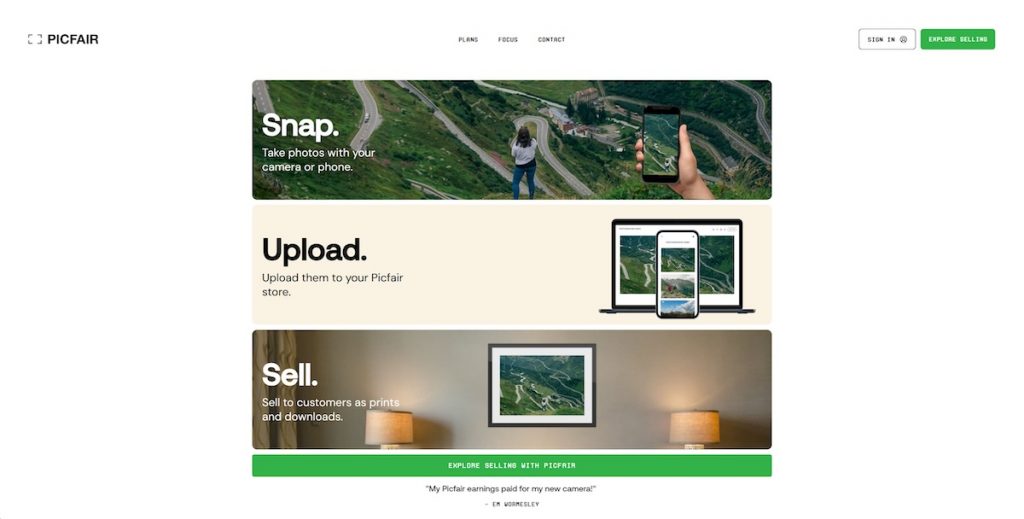
Picfair redefines the concept of selling photos online by combining the simplicity of a personal storefront with the reach of a global marketplace. Unlike many platforms that require photographers to build and manage every aspect of their gallery, Picfair handles much of the heavy lifting—allowing users to launch a professional-looking store in minutes, no coding or design skills required. Their subscription model is straightforward: the basic version is free and includes marketplace access, while Picfair Plus ($6/month or $60/year) adds custom domain support, advanced store features, and commission-free sales through your personal store.
One of Picfair’s standout strengths is its dual approach to photo sales. Photographers can sell photos via their own branded store or through Picfair’s larger marketplace, which receives traffic from image buyers across the globe. The platform supports digital downloads, personal-use licenses, commercial licenses, and even prints—making it flexible for both casual creators and working professionals. The licensing is fully automated and transparent, helping photographers earn fairly without worrying about the legal complexities.
Picfair also partners with print labs to offer high-quality physical products, including framed and canvas prints, available for global delivery. It’s an especially attractive option for photographers who want a low-effort, high-reward way to monetize their work, all while maintaining creative control and fair pricing. Picfair is ideal for those who value exposure, simplicity, and a no-nonsense sales structure.
On-Demand Print Marketplaces
On-demand print marketplaces offer photographers a unique way to sell photos online beyond traditional licensing or gallery sales. These platforms allow you to upload your photos and earn money by selling them as physical products—ranging from art prints and posters to home decor, apparel, and accessories—without handling inventory, printing, or shipping.
With global customer bases and built-in manufacturing partners, on-demand print marketplaces are a great option for photographers looking to expand their reach and generate passive income. Whether you’re a fine art creator, landscape photographer, or someone with a strong visual aesthetic, these platforms make it easy to turn your images into sellable products for everyday consumers.
Etsy
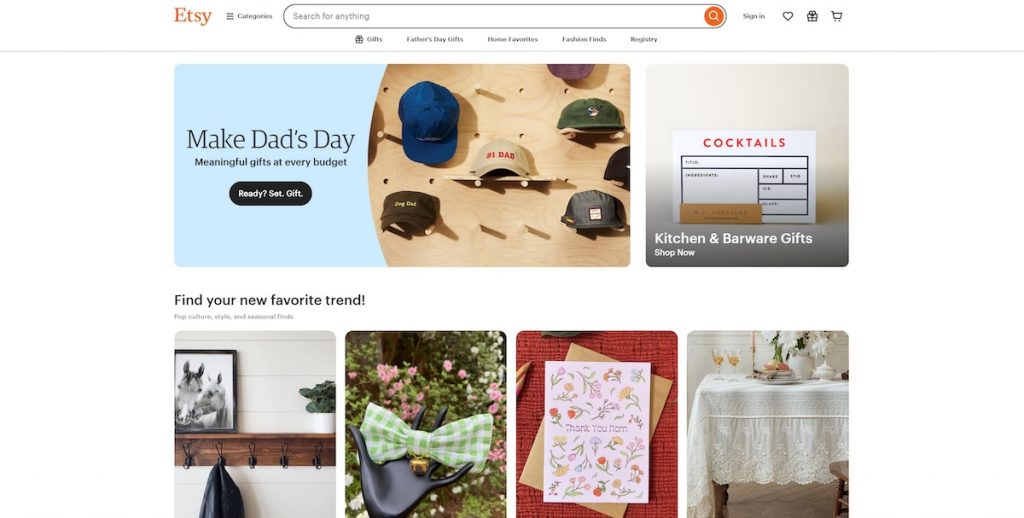
Etsy may be best known for handmade crafts and vintage goods, but it has also become a thriving marketplace for photographers selling physical prints and digital downloads. Unlike traditional stock platforms, Etsy gives sellers full control over branding, pricing, and product presentation, allowing photographers to create highly personalized storefronts. You can list everything from art prints and photo calendars to downloadable wall art, targeting a consumer audience interested in home decor, gifts, and unique visuals. There are no monthly fees to open a shop—just a $0.20 listing fee per item and a 6.5% transaction fee, along with payment processing charges.
What sets Etsy apart is its enormous buyer base and search-friendly platform, which rewards well-optimized listings with high visibility. Photographers can bundle prints, offer customization, run discounts, and take advantage of Etsy Ads to drive traffic to their shops. However, sellers are responsible for order fulfillment unless using a third-party print-on-demand integration like Printful or Gooten, which can automate printing and shipping. This gives you flexibility: you can fulfill orders yourself for greater profit margins or outsource for convenience.
Etsy is ideal for photographers with a strong visual brand who want to turn their work into tangible products for a lifestyle-driven audience. While it doesn’t operate like a traditional photo marketplace, it offers a creative, high-potential avenue for photo entrepreneurs who want to build a direct-to-consumer presence.
Karin van Mierlo, a photography mentor at Photography Playground, points out, “For photographers selling landscape, fine art, botanical, or travel prints, Etsy can be a worthwhile platform—but it’s important to go in with clear expectations. It’s not a quick path to passive income. Like photography itself, selling on Etsy takes intention, consistency, and a strong sense of your visual voice. You’re building trust with buyers through every part of your shop: your photos, your product descriptions, your pricing, and your presence. For photographers grounded in storytelling and authenticity, Etsy can offer a meaningful way to share their work.”
Redbubble
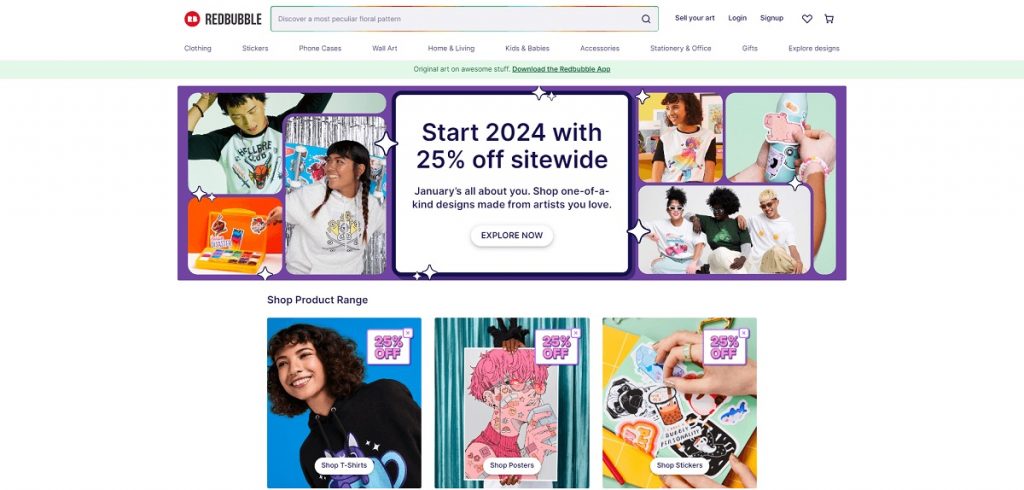
Redbubble is a popular on-demand print marketplace where photographers can turn their images into a wide variety of products without worrying about production or shipping. Once you upload your work, Redbubble allows you to sell it on everything from art prints and posters to clothing, phone cases, stickers, home decor, and more. The platform handles printing, packaging, and delivery, making it a hassle-free option for photographers looking to generate passive income through merchandise. Setting up a shop is free, and creators can upload photos and earn money through royalties, with the ability to set their own markup above Redbubble’s base price.
Redbubble’s audience leans heavily toward creative, design-forward consumers, making it a great fit for photographers with work that’s bold, aesthetic, or niche. You won’t have access to extensive marketing tools or branding customization, but the platform brings in millions of visitors monthly, giving your photos exposure without upfront investment. While you won’t have full control over the buyer experience, the sheer range of products and ease of use make Redbubble a low-barrier entry point into e-commerce.
Overall, Redbubble is best suited for photographers who want to expand into the art merchandise space without the complexities of inventory management. It’s ideal for those with a distinctive style who want to see their work on everyday items and tap into a vibrant global marketplace.
Society6

Society6 is a curated on-demand print marketplace that allows photographers and visual artists to sell their work as premium lifestyle products. Focused on design-conscious consumers, Society6 transforms your photos into high-quality items like art prints, canvas wraps, framed prints, wall murals, and even home goods such as furniture, rugs, and bedding. As a photographer, all you need to do is upload your photos and earn money—Society6 takes care of the printing, packaging, and global shipping. The platform is free to join, and you earn a standard 10% royalty on most products, with the option to set custom markups on art prints.
What makes Society6 unique is its emphasis on product quality and its aesthetic-driven marketplace. It attracts a loyal customer base looking for gallery-worthy artwork and home decor with a modern or artistic edge. While it doesn’t offer deep customization for your storefront or extensive marketing tools, Society6’s curated feel and stylish product presentation help your work stand out. The trade-off is less creative control over branding but access to a high-end audience and seamless print fulfillment.
Society6 is a strong option for photographers whose work blends art and design—particularly those who want to tap into the home decor space without managing logistics. It’s ideal for minimalist, abstract, or fine art photography that translates well into physical, design-forward products.
How to Sell Your Photos

Once you’ve built a solid collection of images, the next step is getting them in front of the right audience—and that takes more than just uploading to a website. Successful photo sales depend on how well you position, promote, and protect your work. Here are five essential strategies to help you sell your photos online more effectively.
Offer Direct Sales for Event-Based Photography
Selling photos directly to customers is especially effective for event-based work such as school picture days, sports tournaments, concerts, or community events. Instead of relying on stock marketplaces, you can create a streamlined, high-conversion workflow using platforms like SmugMug, Pixieset, or Pic-Time.
Start by setting up your gallery on one of these platforms before the event. Most allow you to customize the storefront, pricing, and purchase options in advance. On the day of the shoot, capture your photos as usual—or use tethered shooting to upload images in real time, depending on the setup and internet access. This can speed up your turnaround and keep your workflow efficient.
After the event, finish any necessary editing and upload the final images to your pre-set gallery if you haven’t already. Organize the photos by class, team, or individual to make browsing easier. Platforms often support search features, tagging, and even facial recognition to help attendees quickly find their images.
Promote your gallery before and after the event. Share access via email, text, or physical handouts with QR codes—especially helpful for schools or large events. Announce when the gallery is live and highlight any early-bird discounts or limited-time offers to drive quick sales.
Once visitors access the gallery, they can easily browse, select, and purchase their photos in digital or print formats. Make sure that the process is smooth and mobile-friendly, which helps boost conversion rates. With this workflow in place, you’re not just selling photos—you’re delivering convenience, personalization, and a professional service directly to the event participants.
Use Relevant Keywords and Descriptions
When you upload your photos to stock sites or your own website, adding accurate and descriptive keywords is critical. Think like your customer: what would they search for to find your image? Include specifics like location, activity, emotions, colors, and any defining elements (for example, “Asian family celebrating Lunar New Year” or “female athlete mid-jump on track”). Strong metadata not only improves your search visibility but also increases the chances of your photos being discovered in a crowded marketplace.
Promote on Social Media
Your social media channels can be powerful tools for attracting attention to your work. Share your best shots on platforms like Instagram, Pinterest, Facebook, or TikTok, using relevant hashtags and geotags to reach targeted audiences. If you shoot niche content—like school portraits or local sports—join community groups and tag people or organizations involved (with permission). Social media isn’t just about showing off your portfolio; it’s a place to build trust, tell stories behind your images, and drive traffic to your photo listings or online store.
Understand Your Legal Rights
Before selling any photo, make sure you have the right to do so. If your image includes recognizable people or private property, you may need model or property release forms—especially for commercial use. Each platform has its own rules, so it’s important to read the fine print. Understanding copyright law is also key; by default, you own the rights to your photos, but when you license them, you’re granting others specific usage rights. Make sure you know what you’re giving away and what you retain.
Maintain a High-Quality Collection
First impressions matter. A cluttered gallery or inconsistent quality can turn potential buyers away. Make sure every photo you upload meets high standards for resolution, composition, and editing. Use consistent lighting and color correction, and remove duplicates or subpar shots. The stronger and more cohesive your portfolio looks, the more professional you’ll appear—and the more likely people are to purchase from you.
By putting these methods into action, you’ll be better positioned to turn your photography into a steady income stream. It’s not just about capturing great images—it’s about ensuring they reach the right buyers.
How to Price Your Photos

Pricing your photos can be one of the trickiest parts of selling online. Set them too high, and you might scare off potential buyers; too low, and you risk undervaluing your work. The right pricing strategy depends on your platform, target audience, and the intended use of your images. Here’s how to approach it with clarity and confidence.
Understand Licensing Models
Most online photo sales fall under two main licensing categories: royalty-free and rights-managed.
- Royalty-free means customers pay once and can use the image multiple times within certain limits. This is the most common model on stock photography sites like Shutterstock and Adobe Stock.
- Rights-managed allows more control and exclusivity—you license the photo for a specific use, duration, and region. These images usually command higher fees and are ideal for premium or niche content.
Choosing the right model depends on your goals. Royalty-free is best for high-volume, passive income, while rights-managed is better suited for fewer, higher-paying clients.
Set Tiered Pricing Based on Usage and Format
If you’re selling photos directly through your own site or a marketplace like Etsy, consider offering different price points for different formats:
- Low-res for web use: Ideal for bloggers and small businesses
- High-res for print or commercial use: Priced higher due to broader rights
- Prints: Priced according to size, framing options, and delivery costs
You can also offer packages like “5 images for $30” to incentivize bulk purchases and increase order value.
Factor in Platform Fees and Commissions
Many stock photography platforms take a significant portion of your earnings—sometimes up to 60%. When setting your prices or choosing which platform to use, factor in these commissions. For example, if a platform pays $0.25 per download, you’ll need to sell photos in volume to see meaningful income. On the other hand, selling independently lets you keep a larger share but may require more effort in marketing and customer service.
Consider the Value of Your Work
Not all photos should be priced the same. Unique, hard-to-replicate images—such as drone shots, conceptual art, or exclusive event coverage—can be priced higher. Similarly, if you’ve invested time in detailed retouching, advanced editing, or niche subject matter, your pricing should reflect that effort and expertise.
Offer Subscription Plans or Bundles
To attract repeat buyers or businesses that need content regularly, consider creating subscription plans or bundles. For example, offer monthly access to a curated gallery for a flat fee, or discount sets of 10–20 photos. This model works well for photographers targeting bloggers, content marketers, or local organizations like schools and sports clubs.
Ultimately, your pricing strategy should balance market demand, your creative value, and your long-term goals. Be flexible, test different approaches, and don’t be afraid to raise your prices as your brand and portfolio grow.
Legal Considerations When Selling Photos Online

Selling your photos online isn’t just about aesthetics and marketing—it’s also about staying legally protected. Failing to understand your rights or comply with platform and copyright laws can lead to takedown notices, lost revenue, or even legal trouble. Here are the key legal areas every photographer should be aware of before putting their work up for sale.
Model and Property Releases
If your photo features recognizable people, you’ll need a model release—a signed agreement that gives you permission to use and sell images of that person for commercial purposes. The same goes for property releases if your image features private property, artwork, or locations with restricted rights (like certain buildings or branded items). Editorial images (like news-style photos) often don’t require releases, but they can only be used in non-commercial contexts such as journalism or education.
Always err on the side of caution: if you think an image might require a release, get one signed before uploading or selling. Most stock photo sites will ask for these documents as part of the submission process.
Understand Copyright Basics
By default, you own the copyright to every image you take. This means no one can legally use, copy, or sell your work without your permission. When you sell a photo or license it to a buyer, you’re not giving away ownership—you’re granting certain rights to use the image under specific conditions. Be clear on what you’re licensing:
- Is it for one-time use or unlimited?
- Is it for commercial or personal use?
- Is the buyer allowed to alter or redistribute the image?
Using clear licensing terms helps protect your rights and avoid misunderstandings down the line.
Know the Terms of Each Platform
Every platform you upload your photos to has its own terms of service and licensing agreements. Some allow you to retain full rights while offering non-exclusive licenses to buyers. Others may require exclusivity, meaning you can’t sell the same photo elsewhere. Always read the fine print to understand how your photos can be used, what rights you’re giving up, and how much control you retain.
Additionally, some platforms may automatically watermark your images or take a portion of your revenue. It’s your responsibility to weigh the pros and cons of each before committing.
Protecting Your Work From Theft
While there’s no way to completely eliminate image theft online, there are steps you can take to reduce the risk:
- Add watermarks to preview images on your website or gallery
- Use low-resolution images for online display and deliver high-res files after purchase
- Register your photos with a copyright office in your country for extra legal protection
- Use tools like Google Reverse Image Search or Pixsy to monitor unauthorized use of your photos
Being proactive about protecting your work ensures that your creative effort doesn’t get exploited without proper credit or compensation.
Understand Tax Obligations
Once you start earning income from photo sales, you may be required to report it for tax purposes, depending on your country’s laws. Keep detailed records of your earnings, expenses (like gear, editing software, or hosting fees), and any platform commissions. You might qualify for deductions as a self-employed creative, but it’s always best to consult a tax professional familiar with freelance or digital sales.
Navigating the legal side of photography might feel overwhelming at first, but it’s essential for running a sustainable and professional business. By understanding your rights and responsibilities, you can confidently sell your photos online without worrying about legal pitfalls.
Tools and Resources You Need

To sell photos online effectively, having the right tools in place can make a huge difference in how you create, present, and protect your work. Below are essential resources every photographer should consider using.
Keyword Research Tool
Using strong keywords is critical for making your photos discoverable on stock sites and search engines. Tools like Google Keyword Planner, Ubersuggest, or Ahrefs can help you find relevant and high-traffic keywords related to your photo themes. This is especially useful when writing titles, descriptions, or tags, helping your images appear in search results and increasing the chances of making a sale. By targeting specific niches—such as “school sports day” or “sunset beach portraits”—you attract more qualified buyers. Regular keyword research also helps you stay on top of trending topics and seasonal demand.
Culling and Editing Software
Efficient photo culling and editing tools are a must—especially when managing hundreds of images from events like sports matches or school photos. Photo Mechanic is excellent for fast culling, while Lightroom and Photoshop remain industry standards for editing. For a more efficient workflow, AI software like Aftershoot, Imagen, or Honcho can automatically cull, edit and deliver your photos, with Honcho offering additional features like instant sharing via facial recognition and QR codes—perfect for high-volume sessions like school or sports photography. Clean, consistent edits help build your brand identity and make your collection look more polished. Investing in proper software not only improves your quality but also increases the perceived value of your work.
Online Portfolio
A professional online portfolio acts as your visual storefront. Platforms like SmugMug, Format, or Squarespace let you showcase your best work, categorize your images by genre, and even sell prints or digital downloads directly. Make sure your portfolio is mobile-friendly, loads quickly, and clearly communicates your style and expertise. A well-curated portfolio builds trust and makes it easier for potential clients to visualize how your photos fit their needs. It’s also a great place to highlight testimonials, case studies, and pricing information.
Contracts and Legal Documents
To protect yourself and your clients, always use clear contracts. These should outline licensing terms, pricing, usage rights, and delivery timelines. Tools like Jotform, HoneyBook, or Bonsai allow you to create, send, and sign contracts digitally. Contracts prevent misunderstandings and ensure that both parties agree on expectations before work begins. Including model and property releases in your workflow is crucial for legal compliance—especially when selling commercially through stock photography platforms.
Wrapping Up
Selling your photos online as stock images is a popular way for photographers to earn passive income. Whether you’re shooting commercial, editorial, or artistic content, stock platforms offer access to a global market of buyers looking for high-quality visuals. To succeed, it’s important to understand how to price your work, navigate legal considerations like model releases and licensing, and make use of tools that streamline editing, keywording, and submission.
Beyond stock libraries, photographers can also monetize their work through online galleries and print-on-demand platforms. These allow for direct sales of prints, home decoration, and merchandise, offering more creative control and brand visibility.
That said, it’s worth noting that the industry has become more competitive in recent years. Steve Heap, a photographer with over 15 years of experience, shared his thoughts on earning money through stock agencies: “It’s getting harder every year. AI-generated images and videos are definitely affecting photos of people, although travel photography remains more resilient—users still need accurate depictions of city skylines, for example, and AI isn’t quite suited for that. These days, I enjoy selling prints more, but that requires a lot of marketing effort. So, give it a try, but don’t expect to get rich!”
Choosing the right combination of platforms—based on your goals, content style, and desired income stream—can help you build a sustainable photography business while reaching audiences worldwide.

